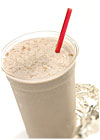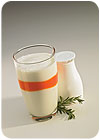
Photo Courtesy of Kerry Ingredients
Dairy Foods Talked to:
Bryan Bradburn, food market specialist, CP KelcoMelanie Dineen, applications technologist, SunOpta Ingredients Group
Eric Hallstead, account manager, stabilizers, Main Street Ingredients
Joe Klemaszewski, senior scientist, dairy applications, Cargill Texturizing Solutions
Gwen Meyer, applications manager, Kerry Bio-Science
Cathy Miller, technical applications director, Danisco
Jenny Norton, food scientist, TIC Gums Inc.
Joseph O’Neill, v.p. sales & marketing, Orafti
Sally Romano, director, sales, marketing and technical services for food & beverage, International Specialty Products
Marion Schlude, global marketing segment manager, food ingredients, Cognis
Bill Shazer, director of laboratories, dairy applications R&D, Tate & Lyle Custom Ingredients
Julie Snarski, manager culinary and foodservice department, David Michael & Co.
Ian Tregaskis, president and CEO, G. C. Hahn & Co. USA Inc.
Ross White, applications manager, FMC BioPolymer
The stabilization of dairy products is becoming increasingly important as opportunities for product innovation present themselves in the retail, foodservice and industrial markets. Performance expectations are more specific and product labeling is more demanding, making the design of stabilization systems more challenging.
Dairy Foodstalked with 14 suppliers of dairy stabilizers to gain insight to current and future trends and advancements in this area of product development. Here’s what they had to say.

dfx1206-dairy-img6.jpg
Dairy Foods: Why stabilize dairy foods?
Tregaskis: There are many reasons. Manufacturers looking to innovate new products that complement current and future trends are often limited by existing equipment. Stabilizers can help. Stabilizers also enable manufacturers to design a formula with a specific price point, as stabilizers can bind water and replace more costly ingredients.Bradburn: There is an aesthetic component of stabilizer use, regardless of dairy application: To provide consumers a product that looks like it did when it was first manufactured, in spite of the fact it has been through transportation, handling and some time on a shelf or in a freezer.
Schlude: These days, texture and mouthfeel are major selling points for any food product, and for dairy products, shelflife is also an important purchasing criterion. Stabilizers can help manufacturers improve their products in all three regards. Products have to stay firm and stable, exhibit excellent freeze-thaw stability or hold complex shapes.
Dineen: Indeed, stabilizers extend product shelflife and improve product quality. Most importantly, stabilizers can influence the mouthfeel of a product and this has a significant impact on consumer acceptability. They can also become vehicles for nutritional enhancement, such as added fiber, omega-3 fatty acids and antioxidants.
Shazer: Stabilizers provide uniformity of quality across batches and production runs. They can also change the nutritional profile of dairy products. For example, they can reduce fat content.
O’Neill: Reasons vary by application, for example, a whipping agent stabilizes the foam in aerosol whipped creams, while a thickening agent bulks up a milkshake. Primary factors in selecting stabilizers range from viscosity, mouthfeel, appearance, emulsifying properties and their stability in a given application. These properties vary according to temperature, humidity, time and pH.
Klemaszewski: Separated chocolate milk in semi-transparent packaging will not be chosen by a customer even though it will resemble a non-striated product upon shaking. Similarly, yogurt and sour cream with syneresis is less appealing than its stabilized counterpart.
White: If everything could be consumed fresh, our needs for stabilization would significantly decrease, but not everyone has a backyard dairy. Stabilizers play a role in all areas of getting a product from field to table.

Photo Courtesy of Kerry Ingredients
Dairy Foods: How do stabilizers function differently in various dairy products?
Miller: Stabilizer selection varies by product. For example, yogurt stabilizers are used to provide body and texture. The base formulation can remain the same and the stabilizer can determine the texture (i.e., spoonable, squeezable, pourable, etc.).Norton: The most important factor is knowing what you want to accomplish with a stabilizer. Do you want something to suspend, add mouthfeel, add viscosity, help replace or mimic fat, create a freeze/thaw product, etc?
White: Stabilizer functionality depends on stabilizer type, use level and synergy with other ingredients, among other variables. The solubility of the stabilizer plays a strong role in how it functions. Some soluble stabilizers, such as carrageenan and alginate, may provide stability based on both interaction and viscosity. Carrageenan interacts with protein as well as itself to provide both fluid and gelled stabilization matrices. It can also interact with other soluble hydrocolloids. Alginate, along with its viscosifying properties, will interact with calcium to provide a matrix for stabilization. Insoluble stabilizers, such as cellulose gel, provide stability in a number of ways including, but not limited to, water management, physical separation and three-dimensional matrix formation, which suspends solids, controls ice crystal growth and maintains air cell structure.
Romano: In chocolate milk, carrageenan is predominantly used to suspend the cocoa; gums such as carboxymethylcellulose and guar will react with the milk protein and cause separation. However, in milkshake mix, one could use guar and xanthan gum to obtain the desired viscosity, while incorporating carrageenan to prevent whey-off. Because of carrageenan’s milk protein reactivity, it cannot be used by itself in milkshake mix, since the required concentration would result in gelation.
Bradburn: In acidic protein drinks, pectins and cellulose gum have a net negative charge. They adsorb onto the surface of milk proteins, which have a net positive charge. Due to the unique structure of the stabilizer, they provide long-term stability in the beverage, with a light, refreshing mouthfeel, or they can provide a full body feeling, depending on the stabilizer grade selected.
Snarski: In frozen desserts, it’s all about mouthfeel and freeze/thaw stability, while in shelf-stable dairy foods, which are typically UHT processed, stabilizers protect the protein against denaturization, suspend particles and contribute to mouthfeel.
Dairy Foods: What are the latest trends in stabilizing ingredients for dairy foods?
Hallstead: Organic stabilizers are the biggest trend we see at the moment. The increase in consumption of organic products has increased the need for high-quality organic products. Organic foods need the same stability as their conventional counterparts. It becomes a matter of adapting existing formulas to meet organic constraints.Meyer: Indeed, natural and organic are growing in awareness. Many of these products incorporate functional ingredients such as omega-3s, plant sterols, prebiotics and probiotics. Since many of these require formulation change, the stabilizer system needs review.
Shazer: With the trend toward nutritional fortification, stabilizers are increasingly important. They suspend insoluble minerals, bind high protein systems, as well as process and distribute formulations with reduced bulk (e.g., low sugar) with equal performance and shelflife to their traditional counterparts.
Dineen: These trends in natural, organic and nutritionally enhanced foods are creating a growing need for specialty stabilizers that function the same as conventional stabilizers. This provides challenges to the developer. For example, traditional ice cream stabilizers such as mono- and di-glycerides and cellulose gel may not have organic and natural counterparts that act as effectively to provide overrun and control ice crystal growth.
Miller: Dairy foods, like other items, are being developed to be eaten on-the-go. Stabilizers can be used to provide stability for items that can be consumed with one hand (i.e., tube yogurt, slow-melt or non-melting frozen novelties, mini pieces, etc.).
O’Neill: Stabilizing ingredients such as inulin extend texture and flavor modification benefits in dairy applications. In addition, they offer a range of nutritional benefits such as boosting calcium absorption, increasing bone mineral density and providing good digestive health through the power of prebiotics. New research even shows that certain oligofructose ingredients may help promote satiety, which can help with the nation’s obesity epidemic. Inulin and oligofructose are both ideal in low-sugar and sugar-free applications. They provide the same bulking effect as sugar and only contribute two calories per gram, as compared to sugar’s four. Inulin and oligofructose are also zero glycemic, since they do not trigger an insulin response. This makes them ideally suited for low-glycemic formulations.

Photos Courtesy of Cargill Texturizing Solutions
Dairy Foods: What benefits are there in purchasing stabilizers as blends with other ingredients?
Klemaszewski: Just as milk changes seasonally, the ingredients used to make dairy stabilizers vary on growth conditions and stage at when they are harvested. For example, carrageenans are derived from multiple species of seaweed or fruits. The functional compounds are extracted and tested and often blended with other extracts so that combined they function uniformly.Schlude: Generally, powders are the ideal form for stabilizers. They are easily blended with other powdered ingredients and they disperse and dissolve much more easily in powder form. Non-powder products are more difficult to incorporate during the manufacturing process, since they often need to be melted or pre-blended. If the melting point of an ingredient is higher than the process temperature, it cannot be used.
Dineen: Stabilizer ingredients can be pre-blended with each other, or with other ingredients such as nonfat dry milk and sugar. This increases the ease of dispersion of all ingredients and helps with hydrocolloid hydration. Some stabilizer ingredients can be co-processed to optimize functionality. These multi-component ingredients allow some ingredients new exposure to areas where they were once not an option due to inherent limitations. Some stabilizers, however, need to be dispersed alone. For example, cellulose gel needs to be dispersed as the first ingredient in some applications to achieve full functionality.
Hallstead: Stabilizers can be blended into complete base mixes where only the fluid product is needed. This reduces the number of incoming products, inventory in the warehouse, labor needed at the plant and the chance of mistakes in weighing numerous ingredients. It also allows for the formulas to be run at multiple plants with less variation in the end product. Blends need to be tailored to meet the processing conditions at the food plant.
White: The key to proper use of soluble hydrocolloids is that they don’t lump when blended. Because of reduced surface area, lumping can result in particles that have a gelled outside surface and a non-hydrated inner surface. Those lumps can hang up in various areas of the process while also creating clogging issues and reducing the needed concentrations of the stabilizer. Other stabilizers, like cellulose gel, require sufficient shear for proper functionality. Most often it is recommended that this shear be applied upfront for ease of processing, but dependent on process capability and configuration, this can often be done later in the process. There are also ingredients that can restrict the proper hydration/solubility of stabilizers. For example, high-salt concentrations added before some stabilizers will hinder their hydration. The important point to remember is that all hydrocolloid stabilizers have some measure of competition for moisture with other stabilizers and other formulation components, e.g., proteins, sugars, etc. Whenever possible, when that potential for competition exists, it is ideal to get stabilizers hydrated first or design specific methods of addition that will not hinder the hydration of any one ingredient. This is often done in fractions where certain ingredients are blended together, hydrated with shear and then sent to a larger blend tank. Each fraction is sent over to the blend tank until all ingredients have been incorporated, then the total blend is further mixed prior to processing.

Dairy Foods: What's new and innovative in stabilizing ingredients for the dairy industry?
Meyer: We have a natural, cultured dairy powder with gum-like properties, which eliminates the need for gums and emulsifiers in natural ice cream, cottage cheese dressing and milk beverages. It can even replace sweetener, some fat and nonfat milk solids.Schlude: A range of whipping agents includes products with different volumizing, stabilizing and sensory properties, so it covers a wide variety of different applications. For example, there’s a product designed specifically for tropical climates because of its higher stability; others are acid-stable, and can be used to incorporate yogurt or fresh fruit juices into mousses.
Snarski: We have an all-natural stabilizer blend that can be used for sorbets. At a usage level of 0.3% to 0.5%, it provides a creamy texture to the mix, one that mimics fat. It also reduces ice crystal formation and size, while assisting with freeze-thaw stability
Tregaskis: We have developed an all-in-one mousse stabilizer. The base can be either yogurt or sour cream. The stabilizer is added at about 2% to 3% with other ingredients to the milk/cream base. The cultured product is made using a traditional process. After cooling, the product is aerated on aeration equipment and then mixed with fruit to produce a luxury fruit mousse dessert.
Norton: A specially formulated stabilizer for dairy beverages with low-total solids, extra fiber and/or protein, additional calcium, etc., provides excellent suspension while adding a slight increase of viscosity to the finished product. It can be used in HTST, UHT and retort applications. Usage levels typically depend on the texture desired; however, 0.6% to 0.8% is the normal range.
Hallstead: Our customer was looking for an ice cream product that would harden well in a large container size, withstand a less than optimum distribution system and be dippable over a variety of temperatures. We were able to do this by combining a stabilizer ingredient with a functional protein in a complete base blend. This allowed the customer to produce at several different plants, as well as meet the demands of their distribution and retail systems.
White: We’ve recently developed both carrageenan and cellulose gel stabilizers that provide superior suspension at lower viscosity than similar systems. In the area of frozen desserts, new cellulose gel-based functional systems have been developed to provide exceptional quality in texture and ice crystal control, while also providing opportunities for fat reduction. These stabilizers provide the qualities of 10% fat ice creams in systems that are only 3% to 5% fat. As well, the qualities of slow-churned products can now be developed without the need for new equipment investment.
Miller: We recently developed a line of patent-pending stabilizers that produce smaller ice crystals in ice cream. This line of stabilizers also has the ability to minimize and control ice crystal growth during heat shock, which is the source of many consumer complaints. Additionally, we have conducted studies that show it can be used to reduce the amount of added milk solids in ice cream. This is very timely since milk solids are in high demand and short supply.
Bradburn: A set of new pectins have been designed to provide outstanding stability for yogurt and yogurt drink products. These products provide a wide range of viscosity and mouthfeel characteristics that allow us to tailor a solution to our customer’s mouthfeel, body and richness requirements. We also have a new texturizer that is a blend of two of our ingredient technologies: microparticulated whey protein concentrate and high-methoxyl-pectin. This ingredient is used to create easily processable whey-juice drinks. In an emerging market in Asia, we were recently challenged by our customer to create an acidified dairy-based beverage that has both protein stability and suspension, but with little added viscosity to the final beverage. By marrying our understanding of rheology with our hydrocolloid knowledge, we created a patent-pending ingredient system, which is extremely low in viscosity and stabilizes protein while maintaining a uniform, consistent body. The product is very refreshing to drink. Sales for our customer indicate that this is a roaring success.
Dineen: We specialize in custom blends and have developed unique ingredient systems to add dietary fiber to milk. We can successfully fortify with both insoluble and soluble fiber, gaining the physiological benefits of both. We have developed a stabilizer system that will suspend the insoluble fiber without developing undesirable viscosity. The custom blends vary in usage level from 1% to 4%, depending on the viscosity and desired fiber level in a given serving size. These stabilizers can be added in a system to the milk where stabilizers are typically added.
Romano: New stabilizer systems based on alginate and phosphate have been optimized for a variety of cheese applications including pizza cheese, cheese sauces and dips, as well as process cheese spreads, blocks and slices. Sodium alginates have a lengthy history of use in dairy applications, due to their unique ability to react with calcium ions. They can be used to thicken or gel a variety of dairy systems, depending on the amount of calcium available to interact with the alginate. Phosphates are typically added to milk-based systems to sequester calcium, to control the rate and extent of the calcium-alginate reaction. Since phosphates are also used as emulsifying salts in processed cheese, sodium alginates are generally compatible with processed cheese formulas. The alginate-phosphate system can reduce stickiness, modify melt characteristics and increase the firmness, structure and hot viscosity of processed cheeses.
Klemaszewski: For years, food manufacturers have been looking for a specialty starch that remains at a low-viscosity during UHT processing while attaining optimum viscosity during the second treatment (when the food is heated in a kitchen, for example). Our new patent-pending functional modified tapioca starch offers such benefits. It has a uniquely low viscosity during the UHT process, and superior stability under high thermal conditions compared with other texturizing agents. At a usage level of 4% to 5%, a cheese sauce increases in viscosity at the second treatment and remains stable for long periods, providing an ideal solution for manufacturers, restaurateurs and consumers. The low viscosity during the UHT process reduces fouling and interruptions to production, and improves heat penetration into the mixture, meaning less energy is consumed. New concepts in packaging and product development have also been made possible thanks to the thick-thin functionality. Since sauces made with this system are thinner after the UHT treatment, the food can be concentrated, meaning that smaller containers and less packaging can be used.

Photo Courtesy of TIC Gums Inc.
Dairy Foods: Any insight to the future of dairy foods and the role of stabilizers?
Miller: The demand for dairy foods is increasing. This is due to many factors, including the increasing ethnic population, increasing average household income and the desire for more healthful eating that is also tasty. Stabilizers can assist with new product development that can be targeted to specific groups, such as kids, teens, women, baby boomers, etc. Each group may prefer different textures and flavors, and stabilizers can assist with these efforts.White: As demands for higher quality, healthy products grow, dairy foods will continue to be in large demand. American consumers want choices, but they also want products that will promote better health and balanced nutrition. Many consumers who formerly reached for carbonated beverages are now reaching for healthier dairy-based beverages. With these growing demands, stabilizers will continue to play a vital role in providing the textures and overall qualities that consumers want while allowing product developers to explore new ideas and category extensions.
